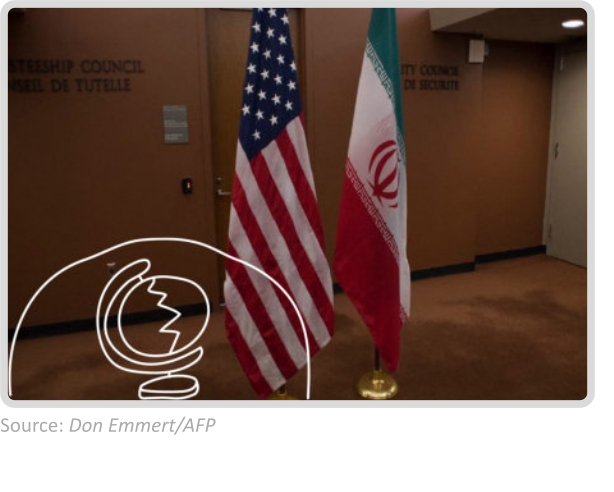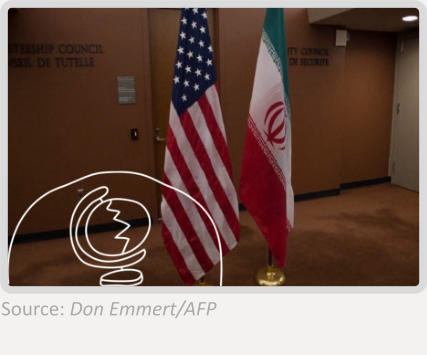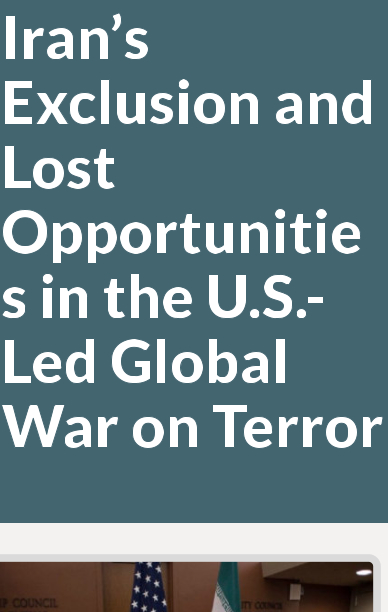

© 2023-2024 Oriental Institute, The Czech Academy of Sciences, Kevin L. Schwartz, and Ameem Lutfi


Days
before
the
U.S.-led
forces
invaded
Afghanistan
to
avenge
the
attacks
on
9/11,
President
George
W.
Bush
out
-
lined
his
approach
to
the
Global
War
on
Terror
(GWOT):
“Our
war
on
terror
begins
with
al-Qaeda,
but
it
does
not
end
there.”
What
followed
was
a
worldwide
coalition,
led
by
the
United
States,
whose
primary
objective
was
to
“destroy
al-Qaeda’s
grip
on
Afghanistan
by
driving
the
Taliban
from
power.”
Twenty
years
later,
on
August
15,
2021,
the
Taliban
returned
to
power
in
Afghanistan.
A
week
later
the
Pentagon
contradicted
the
statement
of
U.S.
President
Joe Biden and acknowledged that al-Qaeda was not completely eradicated from Afghanistan.
One
of
the
more
important
factors
behind
the
U.S.
setback
against
al-Qaeda
in
Afghanistan
–
and
perhaps
the
war
in
Afghanistan
more
generally
–
is
Iran’s
exclusion
from
this
Global
War
on
Terror.
Iran’s
exclusion
was
a
lost
opportunity,
missed
on
two
notable
occasions:
first,
during
the
fight
against
al-Qaeda
in
2001;
and
second,
when
a
coalition
was
built
in
2014
to
fight
against
the Islamic State of Iraq and Syria (ISIS). The U.S. policy of isolating Iran has not only led to the augmentation of Shiʿa extremism but also indirectly fueled Sunni extremist forces.
When
the
U.S.-led
coalition
started
its
operations
against
Afghanistan,
Iran
provided
“
critical
assistance
,”
including
military
and
intelligence
cooperation.
Iran
even
provided
diplomatic
support
in
the
efforts
to
establish
a
new
government
in
Afghanistan
through
the
2001
Bonn
Conference.
But
such
cooperation
was
short-lived
due
to
George
W.
Bush’s
pronouncement
that
Iran
was
a
part
of
the
“Axis
of
Evil.”
The
start
of
Iran’s
nuclear
controversy
in
August
2002
also
adversely
impacted
U.S.-Iran
cooperation.
As
early
as
September
2003,
The
Washington
Post
reported
that
“after
the
fall
of
the
Taliban
in
Afghanistan,
the
locus
of
al-Qaeda’s
degraded
leadership
moved
to
Iran.”
It
is
also
believed
that
“Iran
likely
opened
up
communications
with
al-Qaeda
in
2004
due
to al-Zarqawi’s targeting of Shiite holy sites in Iraq.”
In
recent
years,
Iran’s
ties
with
al-Qaeda
were
highlighted
by
The
New
York
Times
in
its
2020
report
that
al-Qaeda’s
Abu
Muhammad
al-Masri
–
believed
to
be
the
“
next
in
line
to
lead
al-Qaida
”
–
was
secretly
killed
in
Tehran.
Iran
officially
dismissed
this
report
and
“strongly
denied
any
presence
of
the
terrorist
group’s
members
in
Iran.”
This
denial
ran
contrary
to
the
claim
of
U.S.
Secretary
of
State
Mike
Pompeo,
who
claimed
in
early
2021
that
al-Masri
was
shot
dead
in
Iran
the
previous
year.
Pompeo
also
claimed
that
“al-Qaida
has
a
new
home
base:
it
is
the
Islamic
Republic
of
Iran.”
It
is
of
note
that
such
comments
were
made
days
before
Pompeo
was
about
to
leave
office
and
are
evidently
in
line
with
the
efforts
of
President
Trump’s
administration
to
pre-empt
Biden’s
stated
objective
of
resurrecting
the
Joint
Comprehensive
Plan
of
Action
(JCPOA).
Nonetheless,
following
al-Masri’s
death,
The
Washington
Post
reported
that
“the
only
remaining
member
of
al-Qaeda’s
shura
council
—
its
core
leadership
—
with
operational
al-Qaeda
terrorist
experience
is
Saif
al-Adel,
who
is
believed
still
to
be
in
Iran,”
raising
the
prospect
that
an axis between Iran and al-Qaeda remained intact.
While
one
finds
ample
controversy
over
the
relationship
between
Iran
and
al-Qaeda,
there
is
no
such
controversy
between
Iran
and
ISIS.
Iran
and
ISIS
are
bitter
enemies
and
there
is
little
evidence
to
suggest
that
the
two
have
linkages
of
any
kind.
Still,
when
ISIS
declared
a
Caliphate
and
an
international
conference
was
held
in
Paris
on
September
15,
2014
by
the
leaders
of
over
30 countries to discuss the modalities of countering ISIS, Iran was deliberately excluded from this forum.
Nevertheless,
there
was
some
tacit
cooperation
between
Iran
and
the
U.S.
in
their
fight
against
ISIS,
exemplified
by
U.S.
air
support
for
Iranian-backed
Shiʿa
militias
in
Iraq
seeking
to
reverse
ISIS
advances.
Iran
also
reportedly
sent
its
Quds
commander
to
Iraq
in
order
to
safeguard
the
country’s
Shiʿa
Muslims
and
adopted
“an
interventionist
approach
in
Iraq
and
Syria,
largely
through the use of allied militias, including a largely Afghan Hazara group called the Fatemiyoun.”
While
U.S.
President
Barack
Obama
favored
a
strategy
of
strengthening
moderate
opposition
forces
in
Syria
to
fight
both
ISIS
and
Syrian
President
Bashar
al-Assad,
Iran
favoured
the
survival
of
al-Assad’s
regime
and
looked
at
the
U.S.
strategy
with
suspicion.
Moreover,
the
global
coalition
against
ISIS
included
many
Arab
countries;
the
U.S.
feared
that
Iran’s
inclusion
could
have
resulted
in
the
abstention
of
Saudi
Arabia
and
the
United
Arab
Emirates.
President
Obama
may
have
further
calculated
that
including
Iran
in
a
coalition
against
ISIS
could
have
jeopardized
its
bargaining position in nuclear negotiations, opposed by U.S. regional ally Israel.
One
year
after
the
Taliban’s
return
to
power
in
Afghanistan,
it
is
widely
perceived
that
“al-Qaeda
is
regrouping
and
remains
intent
on
becoming
the
leader
of
the
global
jihadist
movement.”
Al-
Qaeda
has
certainly
demonstrated
that
it
has
“learned
the
secret
of
longevity.”
Moreover,
President
Biden’s
administration
is
still
engaged
in
the
fight
against
ISIS.
If
the
U.S.
and
Iran
could
work
on some modalities to cooperate in this regard, perhaps the challenges of Sunni extremism could have been tackled more expediently.
The
U.S.
policy
of
isolation
has
not
necessarily
led
to
the
depletion
of
Iranian
power
or
its
geostrategic
reach.
The
standoff
over
Iran’s
nuclear
program
also
resulted
in
an
acceleration
of
its
nuclear
enrichment.
U.S.-led
sanctions
have
brought
Iran
closer
to
the
two
primary
foes
of
U.S.
power:
Russia,
and
China.
After
four
decades
of
rivalry
with
the
United
States,
Iran
has
certainly
devised
a
strategy
to
fight
its
enemies
far
away
from
its
borders.
Iran’s
regional
proxies
are
part
of
that
strategy.
Notably,
Iran’s
proxies
are
not
confined
to
Shiʿa
groups,
but
include
Sunni
groups
as
well,
such
as
Hamas.
Under
an
environment
wherein
Iran
and
the
U.S.
continue
to
nourish
their
enmity,
Iran’s
asymmetric
power
and
compulsion
of
hedging
may
cause
it
to
widen
the
fold
of
its proxies. One must wonder whether some elements of the U.S.-Iran rivalry might have been more easily resolved if that country had been brought on board in the Global War on Terror.






If you are interested in contributing an article for
the project, please send a short summary of the
proposed topic (no more than 200 words) and brief
bio to submissions@911legacies.com. For all
other matters, please contact
inquiry@911legacies.com.

CONTACT



Days
before
the
U.S.-led
forces
invaded
Afghanistan
to
avenge
the
attacks
on
9/11,
President
George
W.
Bush
outlined
his
approach
to
the
Global
War
on
Terror
(GWOT):
“Our
war
on
terror
begins
with
al-Qaeda,
but
it
does
not
end
there.”
What
followed
was
a
worldwide
co
-
alition,
led
by
the
United
States,
whose
primary
objective
was
to
“destroy
al-Qaeda’s
grip
on
Afghanistan
by
driving
the
Taliban
from
power.”
Twenty
years
later,
on
August
15,
2021,
the
Taliban
returned
to
power
in
Afghanistan.
A
week
later
the
Pentagon
contradicted
the
state
-
ment
of
U.S.
President
Joe
Biden
and
acknow
-
ledged
that
al-Qaeda
was
not
completely
eradicated from Afghanistan.
One
of
the
more
important
factors
behind
the
U.S.
setback
against
al-Qaeda
in
Afghanistan
–
and
perhaps
the
war
in
Afghanistan
more
generally
–
is
Iran’s
exclusion
from
this
Global
War
on
Terror.
Iran’s
exclusion
was
a
lost
opportunity,
missed
on
two
notable
occasions:
first,
during
the
fight
against
al-Qaeda
in
2001;
and
second,
when
a
coalition
was
built
in
2014
to
fight
against
the
Islamic
State
of
Iraq
and
Syria
(ISIS).
The
U.S.
policy
of
isolating
Iran
has
not
only
led
to
the
augmentation
of
Shiʿa
extremism
but also indirectly fueled Sunni extremist forces.
When
the
U.S.-led
coalition
started
its
operations
against
Afghanistan,
Iran
provided
“
critical
assistance
,”
including
military
and
intelligence
cooperation.
Iran
even
provided
diplomatic
support
in
the
efforts
to
establish
a
new
government
in
Afghanistan
through
the
2001
Bonn
Conference.
But
such
cooperation
was
short-lived
due
to
George
W.
Bush’s
pronouncement
that
Iran
was
a
part
of
the
“Axis
of
Evil.”
The
start
of
Iran’s
nuclear
controversy
in
August
2002
also
adversely
impacted
U.S.-Iran
cooperation.
As
early
as
September
2003,
The
Washington
Post
reported
that
“after
the
fall
of
the
Taliban
in
Afghanistan,
the
locus
of
al-
Qaeda’s
degraded
leadership
moved
to
Iran.”
It
is
also
believed
that
“Iran
likely
opened
up
communications
with
al-Qaeda
in
2004
due
to
al-Zarqawi’s targeting of Shiite holy sites in Iraq.”
In
recent
years,
Iran’s
ties
with
al-Qaeda
were
highlighted
by
The
New
York
Times
in
its
2020
report
that
al-Qaeda’s
Abu
Muhammad
al-Masri
–
believed
to
be
the
“
next
in
line
to
lead
al-
Qaida
”
–
was
secretly
killed
in
Tehran.
Iran
officially
dismissed
this
report
and
“strongly
denied
any
presence
of
the
terrorist
group’s
members
in
Iran.”
This
denial
ran
contrary
to
the
claim
of
U.S.
Secretary
of
State
Mike
Pompeo,
who
claimed
in
early
2021
that
al-Masri
was
shot
dead
in
Iran
the
previous
year.
Pompeo
also
claimed
that
“al-Qaida
has
a
new
home
base:
it
is
the
Islamic
Republic
of
Iran.”
It
is
of
note
that
such
comments
were
made
days
before
Pompeo
was
about
to
leave
office
and
are
evidently
in
line
with
the
efforts
of
President
Trump’s
administration
to
pre-empt
Biden’s
stated
objective
of
resurrecting
the
Joint
Comprehensive
Plan
of
Action
(JCPOA).
Nonetheless,
following
al-Masri’s
death,
The
Washington
Post
reported
that
“the
only
remaining
member
of
al-Qaeda’s
shura
council
—
its
core
leadership
—
with
operational
al-
Qaeda
terrorist
experience
is
Saif
al-Adel,
who
is
believed
still
to
be
in
Iran,”
raising
the
prospect
that
an
axis
between
Iran
and
al-Qaeda
remained intact.
While
one
finds
ample
controversy
over
the
relationship
between
Iran
and
al-Qaeda,
there
is
no
such
controversy
between
Iran
and
ISIS.
Iran
and
ISIS
are
bitter
enemies
and
there
is
little
evidence
to
suggest
that
the
two
have
linkages
of
any
kind.
Still,
when
ISIS
declared
a
Caliphate
and
an
international
conference
was
held
in
Paris
on
September
15,
2014
by
the
leaders
of
over
30
countries
to
discuss
the
modalities
of
countering
ISIS,
Iran
was
deliberately
excluded
from
this
forum.
Nevertheless,
there
was
some
tacit
cooperation
between
Iran
and
the
U.S.
in
their
fight
against
ISIS,
exemplified
by
U.S.
air
support
for
Iranian-
backed
Shiʿa
militias
in
Iraq
seeking
to
reverse
ISIS
advances.
Iran
also
reportedly
sent
its
Quds
commander
to
Iraq
in
order
to
safeguard
the
country’s
Shiʿa
Muslims
and
adopted
“an
interventionist
approach
in
Iraq
and
Syria,
largely
through
the
use
of
allied
militias,
including
a
largely
Afghan
Hazara
group
called
the
Fatemiyoun.”
While
U.S.
President
Barack
Obama
favored
a
strategy
of
strengthening
moderate
opposition
forces
in
Syria
to
fight
both
ISIS
and
Syrian
President
Bashar
al-Assad,
Iran
favoured
the
survival
of
al-Assad’s
regime
and
looked
at
the
U.S.
strategy
with
suspicion.
Moreover,
the
global
coalition
against
ISIS
included
many
Arab
countries;
the
U.S.
feared
that
Iran’s
inclusion
could
have
resulted
in
the
abstention
of
Saudi
Arabia
and
the
United
Arab
Emirates.
President
Obama
may
have
further
calculated
that
including
Iran
in
a
coalition
against
ISIS
could
have
jeopardized
its
bargaining
position
in
nuclear
negotiations,
opposed
by
U.S.
regional
ally Israel.
One
year
after
the
Taliban’s
return
to
power
in
Afghanistan,
it
is
widely
perceived
that
“al-Qaeda
is
regrouping
and
remains
intent
on
becoming
the
leader
of
the
global
jihadist
movement.”
Al-
Qaeda
has
certainly
demonstrated
that
it
has
“learned
the
secret
of
longevity.”
Moreover,
President
Biden’s
administration
is
still
engaged
in
the
fight
against
ISIS.
If
the
U.S.
and
Iran
could
work
on
some
modalities
to
cooperate
in
this
regard,
perhaps
the
challenges
of
Sunni
extremism
could
have
been
tackled
more
expediently.
The
U.S.
policy
of
isolation
has
not
necessarily
led
to
the
depletion
of
Iranian
power
or
its
geostrategic
reach.
The
standoff
over
Iran’s
nuclear
program
also
resulted
in
an
acceleration
of
its
nuclear
enrichment.
U.S.-led
sanctions
have
brought
Iran
closer
to
the
two
primary
foes
of
U.S.
power:
Russia,
and
China.
After
four
decades
of
rivalry
with
the
United
States,
Iran
has
certainly
devised
a
strategy
to
fight
its
enemies
far
away
from
its
borders.
Iran’s
regional
proxies
are
part
of
that
strategy.
Notably,
Iran’s
proxies
are
not
confined
to
Shiʿa
groups,
but
include
Sunni
groups
as
well,
such
as
Hamas.
Under
an
environment
wherein
Iran
and
the
U.S.
continue
to
nourish
their
enmity,
Iran’s
asymmetric
power
and
compulsion
of
hedging
may
cause
it
to
widen
the
fold
of
its
proxies.
One
must
wonder
whether
some
elements
of
the
U.S.-Iran
rivalry
might
have
been
more
easily
resolved
if
that
country
had
been
brought
on
board in the Global War on Terror.
© 2023-2024 Oriental Institute, The Czech Academy of
Sciences, Kevin L. Schwartz, and Ameem Lutfi


Written by
Asif Shuja




If you are interested in contributing an article for the
project, please send a short summary of the proposed
topic (no more than 200 words) and brief bio to
submissions@911legacies.com. For all other
matters, please contact inquiry@911legacies.com.

CONTACT


















